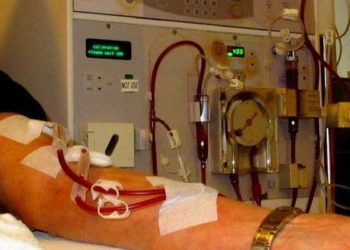Multidisciplinary approach linked with increased utilization of peritoneal dialysis for new dialysis patients
1. In this retrospective quality improvement cohort study from the United States, a multidisciplinary approach was linked with increased rates of peritoneal dialysis initiation compared with national averages
Evidence Rating Level: 2 (Good)
Study Rundown: Chronic kidney disease is one of the most prevalent chronic diseases in North America, with enormous societal burden. There is low quality evidence suggesting comparable or better outcomes with peritoneal dialysis over hemodialysis when starting renal replacement therapy. Rates of peritoneal dialysis in the United States have historically been lower than in other countries with comparable health outcomes.
This was a retrospective cohort and quality improvement study running between 2008 and 2018, with 13500 patients in the United States. It found that a multidisciplinary intervention was linked with increased initiation rates of peritoneal dialysis (15.2% to 33.8% of all dialysis initiations) and increased rates of peritoneal dialysis maintenance at 1 year (69.1% to 84.2%). There was no temporal changes in mortality for patients starting peritoneal dialysis or hemodialysis. Overall, this study supports the feasibility of a large scale quality improvement project to increase rates of peritoneal dialysis initiation, which is associated with better quality of life and lower costs.
Click to read the study in JAMA Internal Medicine
Relevant Reading: Effect of starting with hemodialysis compared with peritoneal dialysis in patients new on dialysis treatment: A randomized controlled trial
In-Depth [retrospective cohort]: This was a retrospective cohort study performed through the Kaiser Permanente Northern California integrated health delivery system. It ran from January 2008 through December 2018 with a multicomponent strategy aimed at increasing the use of peritoneal dialysis (PD). The four components included patient and family education, health care professional and organizational education, operational system-level improvements, and monitoring and continuous quality improvement.
Inclusion criteria was age 18 or older initiating renal replacement therapy during this time period. Exclusion criteria included history of kidney transplant. Primary outcome was initiation of peritoneal dialysis vs hemodialysis (HD). Secondary outcomes included persistence of PD, defined as proportion of patients alive and still receiving PD at 1 year or who died receiving PD within that year (without switching to HD). A total of 13500 patients were included in the analysis. Over the 11 year period, 3460 (25.6%) initiated PD with the remainder initiating HD. Mean age was 64.3. 58.1% were male. Rates of PD initiation roughly doubled during the study period, with 165 of 1089 patients (15.2%) in 2008 compared with 486 of 1438 in 2018 (33.8%) initiating PD rather than HD (p< 0.001). The national average during this time increased from 6.1% to 9.7% over this time. During the study period, 1 year maintenance rate of PD was 80.3%. Rates of PD maintenance increased from 69.1% in 2008 to 84.2% in 2017 (p<0.001). 1 year mortality rates did not change significantly among patients initiating PD (5.5% in 2008 to 7.3% in 2017, p=0.12) or HD (17.3% in 2008 to 15.5% in 2017, p=0.89).
Image: PD
©2019 2 Minute Medicine, Inc. All rights reserved. No works may be reproduced without expressed written consent from 2 Minute Medicine, Inc. Inquire about licensing here. No article should be construed as medical advice and is not intended as such by the authors or by 2 Minute Medicine, Inc.







